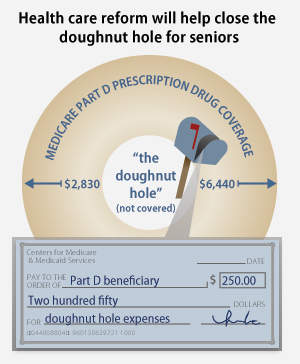 The Centers for Medicare and Medicaid Services sent out partial rebates this week to 80,000 Medicare Part D prescription drug program enrollees who have already reached the notorious gap in coverage known as the doughnut hole.
The Centers for Medicare and Medicaid Services sent out partial rebates this week to 80,000 Medicare Part D prescription drug program enrollees who have already reached the notorious gap in coverage known as the doughnut hole.
Once enrollees’ total drug spending reaches a specified amount, they have to pay the full cost of all the prescription drugs they need until the drug costs reach an upper threshold, where catastrophic coverage kicks in. These increased out-of-pocket costs lead many Part D beneficiaries to reduce, alter, or altogether stop the drug regimen recommended by their doctors. The rebates CMS is sending out this week are the first step in the new health reform law’s provisions that will close the coverage gap by 2020.
The numbers below illustrate the difficulties that Medicare Part D enrollees experience in trying to maintain their recommended drug regimens and what health reform can do to help them.
What is the doughnut hole?
- This year, enrollees will enter the doughnut hole when their total drug spending equals $2,830. This coverage gap extends to $6,440 in total drug spending.
- Some Medicare Part D plans have the flexibility to provide some coverage in this gap, but approximately 80 percent of them do not offer any gap coverage.
- Monthly prices of the top name brand drugs used by Part D beneficiaries increased between 20 percent and 25 percent from 2006 to 2010, driving up costs for individuals in the doughnut hole.
Who is affected by the doughnut hole?
- Approximately 27.6 million Americans were enrolled in Medicare Part D as of February 2010.
- More than one in four, or 26 percent, of Medicare Part D enrollees who filled any prescriptions in 2007 (excluding beneficiaries who received low-income subsidies) reached the coverage gap.
- Some plans offer coverage for Part D beneficiaries once they reach the gap, but most do not—85 percent of enrollees who reached the doughnut hole remained there and had to continue paying the full cost of prescription drugs out of pocket.
- Nearly half, or 49 percent, of Part D beneficiaries who are on Alzheimer’s treatments reach and remain in the doughnut hole.
- About a third, or 33 percent, of Part D beneficiaries who are on statins for high cholesterol reach the doughnut hole and remain there. They represent 40 percent of Part D beneficiaries that reach the coverage gap.
- Nearly a third, or 30 percent, of Part D beneficiaries who are on ACE inhibitors for hypertension and congestive heart failure reach and remain in the doughnut hole. They represent 28 percent of Part D beneficiaries that reach the coverage gap.
- Ultimately, 3.4 million Part D beneficiaries reached the coverage gap in 2007.
Some beneficiaries stop taking medications once they reach the doughnut hole
- Part D beneficiaries decreased their prescription drug use by approximately 14 percent once they reached the doughnut hole.
- 10 percent of Part D beneficiaries who were using medications for diabetes stopped taking them once they reached the doughnut hole.
- 18 percent of Part D beneficiaries who were taking osteoporosis medication stopped taking it once they reached the doughnut hole.
Health care reform will help close the doughnut hole
- CMS will mail out partial rebates this week to 80,000 Part D beneficiaries who have reached the coverage gap, and will continue to mail out rebate checks to beneficiaries quarterly, as they reach the gap.
- The president said in a recent speech that more than 4 million Part D beneficiaries will receive rebate checks by the end of this year.
- Beginning in 2011, Part D beneficiaries who reach the doughnut hole will get a 50 percent discount. This will be phased up to a 75 percent discount on brand name drugs by 2020 and a 7 percent discount on generic drugs—bringing costs to Part D beneficiaries back down to 25 percent (standard coverage level), thereby effectively closing the doughnut hole.
For more about the new health care reform law, see: